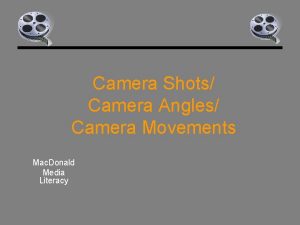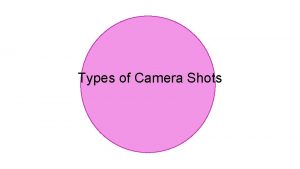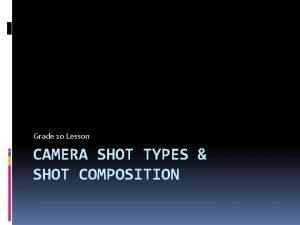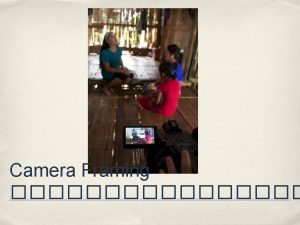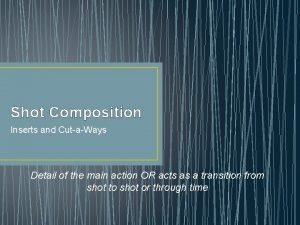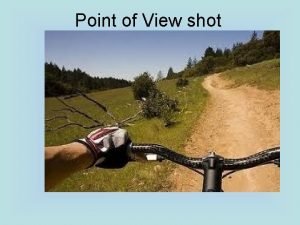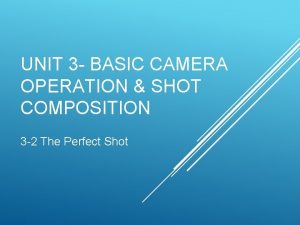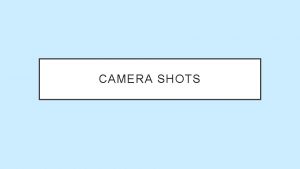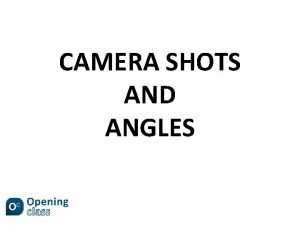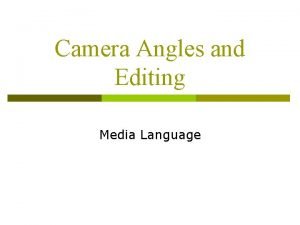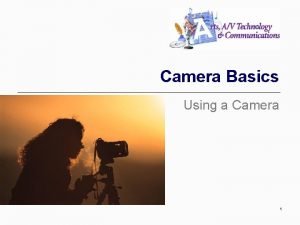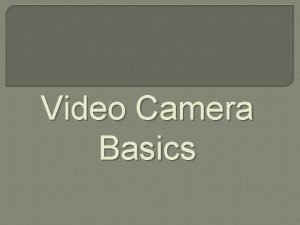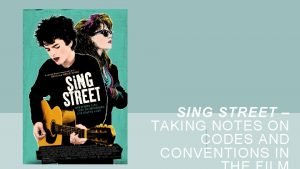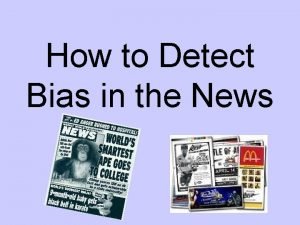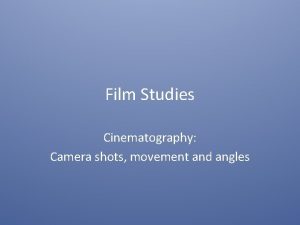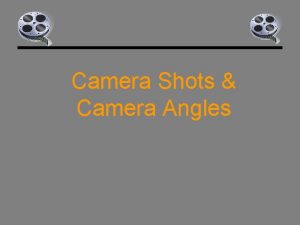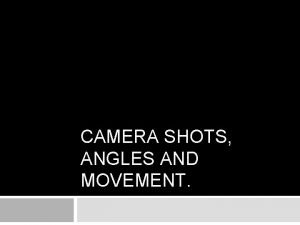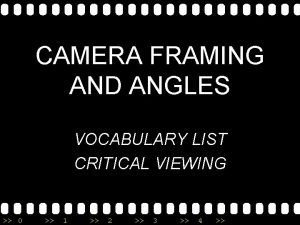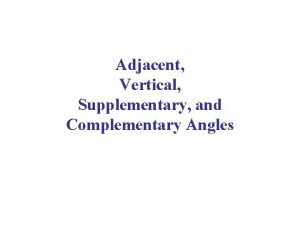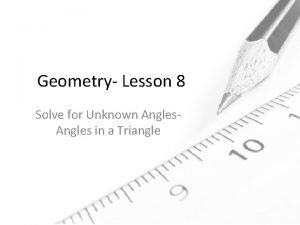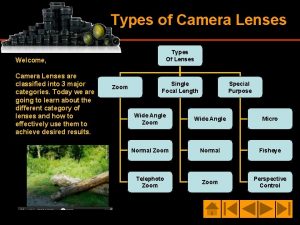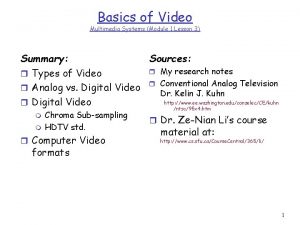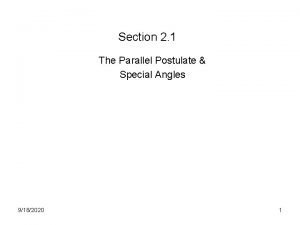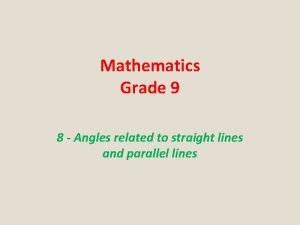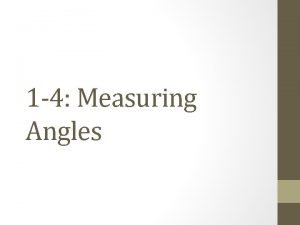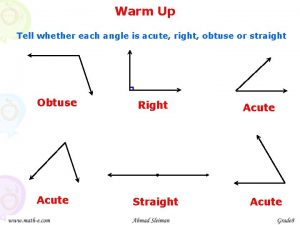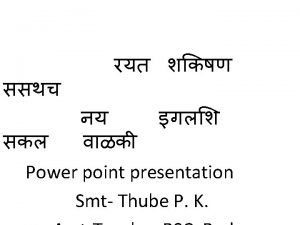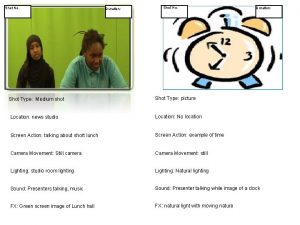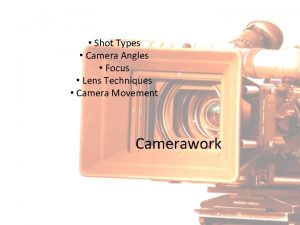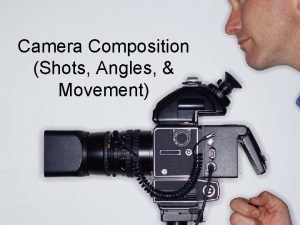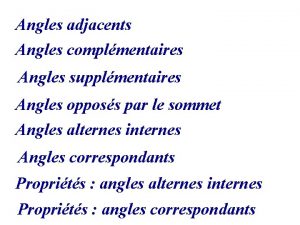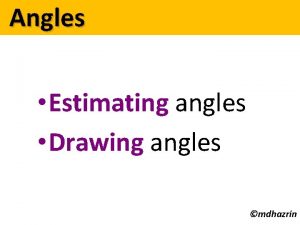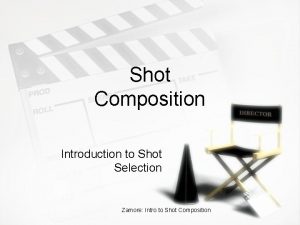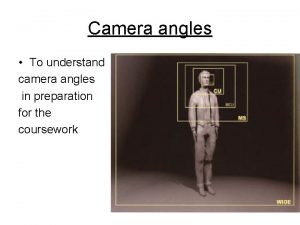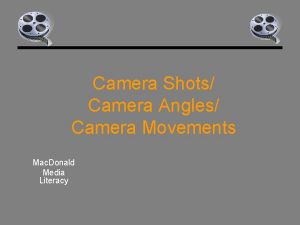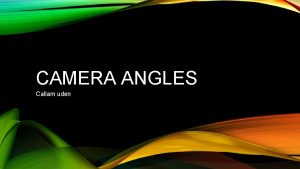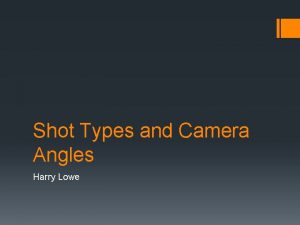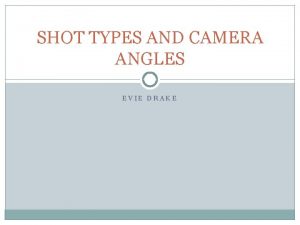Intro to Video Composition Shot Types Camera Angles






























































- Slides: 62

Intro to Video Composition Shot Types Camera Angles & Composition

Shot Types n The shot type refers to how close or far you are from your subject and who is in the shot.

Wide Shot (WS) n A shot taken from far away ¡ ¡ Sometimes used to show where the next scenes are taking place If it is of a person, it is usually from head to toe

Establishing Shot (ES) n A wide shot that is used to set the scene

Medium Shot (MS) n The Medium Shot is closer than the Wide Shot. The viewer feels more a part of the action.

Close-Up Shot (CU) n A Close-Up Shot shows a subject's face and shoulders. It is close enough to show subtle facial expressions clearly.

Extreme Close-Up Shot (XCU) n An Extreme Close-Up Shot shows only a part of a character's face. It fills the screen with the details of a subject.

Two Shot n Shows two people side-by-side

Over the Shoulder (OTS)

Over the Shoulder (OTS) n Useful in an interview situation

n Video. Maker’s Shot Types: http: //www. youtube. com/watch? v=Tu. G v. Ru 5 N 9 v 4&feature=channel

Camera Angles n High-Level Angle n Eye-Level Angle n Low-Level Angle

Camera Angles High Angle Shot In order to shoot a high angle, the camera must be placed above the actors or objects, looking down. This is also called a “bird’seye view. ” This angle is used to make the actors or objects appear more insignificant, small, or weak—depending on how extreme the angle is.

Camera Angles Eye Level Shot To film this shot, the camera is placed level with the subject’s eyes. When we’re at the same level as a character’s eyes, we sympathize with that character. We “feel” what she feels.

Camera Angles Low Angle Shot To film this shot, the camera is placed lower than the person or object to be filmed. A low angle is used when you want to depict the power or importance of an individual or object.

Camera Angles Dutch Angle In order to film a Dutch angle, the camera has to be tilted to the right or left. A Dutch angle is used to signify suspense or to foreshadow that something unexpected is about to happen. A Dutch angle is also called a canted angle.

Rules of Composition n What is composition? Composition is the way you arrange the items you are filming on the screen. Do you want to put them on the right side of the screen? Left? Top? Bottom?

Rule of Thirds

Rule of Thirds n Objects, people, and the horizon should usually fall on one of the lines or the points that cross. n Placing the main subject at the intersection of these lines helps to focus attention on the subject.

Rule of Thirds n No Matter how wide or close a shot, you should put eyes on the upper third line.

Rule of Thirds n Notice how the bike hub is placed in the bottom, right hand corner of the photo.

Rule of Thirds

Rule of Thirds

Rule of Thirds

Rule of Thirds

Rule of Thirds

Rule of Thirds

Rule of Thirds

Rule of Thirds

n n Jim Shorts: Rule of Thirds: http: //www. youtube. com/watch? v=ri 9 u 1 k. VHf j. Y&feature=Play. List&p=7 E 97 BAC 60 AF 278 A 2&playnext=1&playnext_from=PL&index=21 Video. Maker’s Rule of Thirds: http: //www. youtube. com/watch? v=Gj. FUGAV 2 dq. M&feature=Play. List&p=2 EC 843818 E 71 A 442&index=0&playnext=1

Head Room ¡ ¡ ¡ Perfect ! Make sure that the person’s eyes fall on the upper third line. Too close to the top and the person’s head is chopped off Too close to the bottom and the person looks like they are sinking

Head Room Too little

Head Room Too little Too much

Head Room Too little Too much Perfect!

Head Room Zoom to maintain correct head room

Head Room Don’t cut off the chin!

Head Room Don’t cut off the chin!

Lead Room and Nose Room n When someone is walking or running in a video, make sure that there is plenty of room in front of them.

Lead Room and Nose Room n When someone is talking, give them nose room

Lead Room and Nose Room n Too little nose room

Lead Room and Nose Room

Lead Room and Nose Room

Lead Room and Nose Room

Lead Room and Nose Room

Directing Attention n Use color to direct a viewer’s attention to something n Put your subject on a contrasting background to make it “pop. ”

Directing Attention n Frame the subject with objects such as branches, signs, or walls. This directs attention to the subject.

Leading Lines n Guide the viewer’s eye to the subject of your shot

Simulating Depth n By placing an object or person closer to the camera it increases the depth in the picture. This helps the video look more 3 D and less flat.

Simulating Depth

n n Video. Maker on Depth of Field: http: //feeds. videomaker. com/videomak er/vidcast/low Random Samples of Video showing pull focus / depth of field: http: //www. youtube. com/watch? v=0 l 1 x By. HBx. O 4

Visual Organization n Simplicity: The simpler and less cluttered the shot is, the clearer it will be to the viewer

Lifeless Shots n In a photo it is okay to have a person “pose. ” In a video, though, you need to show movement and action.

“Clearing the frame” n When your subject moves, don’t stop recording until the subject has left the shot completely

Backlighting

n Opening of HIGH NOON: http: //www. youtube. com/watch? v=QKL v. KZ 6 n. Ii. A&feature=fvw

Camera Movement n Camera movements should always be slow and steady, never sudden or shaky.

Minimize Shakes n Minimize shaky shots by using the tripod. n Shaky footage is further exaggerated by zooming in. n Camera movements should begin and end with a static shot.

Pan n Camera movement in a horizontal direction.

Tilt n Camera movement in a vertical direction.

Zoom n Changes the focal length of the lens, making the subject seem closer to the camera.

Dolly n Physically moving the camera closer or farther from a subject.

n Are there any questions?
 Long shot camera angle
Long shot camera angle Long shot angle
Long shot angle Xls camera shot
Xls camera shot Long shot vs wide shot
Long shot vs wide shot Camera shot types
Camera shot types Vertically opposite angles are congruent
Vertically opposite angles are congruent Camera angles and shots
Camera angles and shots Ews shot
Ews shot Insert shot
Insert shot What is a point of view shot
What is a point of view shot Raskins 7 parametre
Raskins 7 parametre Wide shot medium shot close up
Wide shot medium shot close up Shooting list template
Shooting list template Basic camera shot
Basic camera shot Vls shot
Vls shot High angle shot reference
High angle shot reference Bcu shot type
Bcu shot type Extreme long shot drawing
Extreme long shot drawing Crane or boom shot
Crane or boom shot Birds eye view camera shot
Birds eye view camera shot Establishing shot camera angle
Establishing shot camera angle Lion angle
Lion angle Examples of multi camera productions
Examples of multi camera productions Camera moves
Camera moves Master editing meaning
Master editing meaning Digital video camera basics
Digital video camera basics Video conference camera
Video conference camera Video camera functions
Video camera functions Sing street notes
Sing street notes Technical codes camera angles
Technical codes camera angles Bias through statistics and crowd counts
Bias through statistics and crowd counts Examples of bias through statistics and crowd counts
Examples of bias through statistics and crowd counts Cinematography angles
Cinematography angles Camera shots and angles quiz
Camera shots and angles quiz Camera shots angles and movements
Camera shots angles and movements List of camera angles
List of camera angles Close up shot example
Close up shot example Game camera angles
Game camera angles Bias through selection and omission guiding questions
Bias through selection and omission guiding questions Videos yandex search
Videos yandex search Video.search.yahoo.com
Video.search.yahoo.com Videos yahoo search
Videos yahoo search The frame size of a video refers to the video’s
The frame size of a video refers to the video’s Adjacent supplementary angles examples
Adjacent supplementary angles examples Lesson 8 solve for unknown angles angles in a triangle
Lesson 8 solve for unknown angles angles in a triangle Segment relationships in circles lesson 15-4
Segment relationships in circles lesson 15-4 Gv black
Gv black Types of hook
Types of hook Camera movement diagram
Camera movement diagram Types of camera lenses
Types of camera lenses Types of camera lenses
Types of camera lenses Types of video signals
Types of video signals Types of video in multimedia
Types of video in multimedia Types of special angles
Types of special angles Types of angles grade 8
Types of angles grade 8 Linear pair postulate
Linear pair postulate Undefined terms in geometry
Undefined terms in geometry Complementary linear vertical adjacent
Complementary linear vertical adjacent Triangles types and angles
Triangles types and angles Thematic paragraph example
Thematic paragraph example Exposé sur les contemplations de victor hugo
Exposé sur les contemplations de victor hugo Introductory paragraph meaning
Introductory paragraph meaning How to introduce a comparative essay
How to introduce a comparative essay
